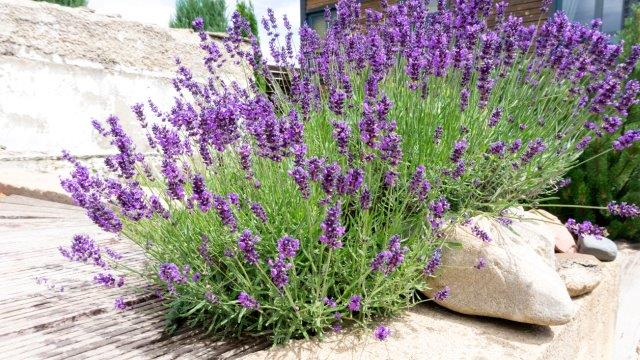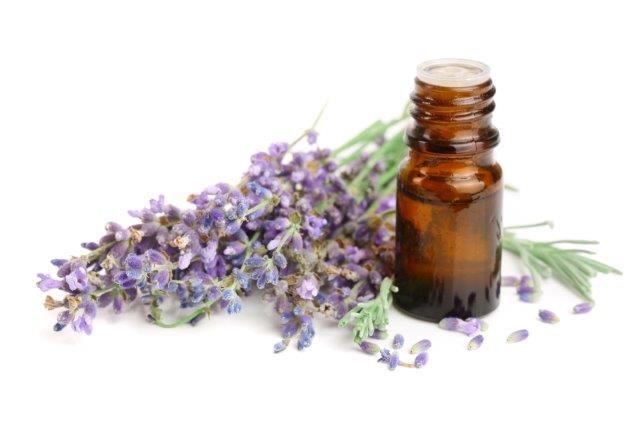- Scientific Name: Lavandula
- Hardiness Zone: Annual, Perennial Zones 5-9
- Days to Harvest: 70-90 days (from date of transplanting)
- Days to Maturity: 2nd Year
- Days to Germination: 14-28
- Seeding Depth: Press into soil without covering
- Plant Width: 24-48"
- Plant Height: 24-48"
- Growth Habit: Woody and herbaceous mounding shrub
- Soil Preference: Average, loose, sandy, well-drained
- Temp Preference: Cooler, 40-65°F
- Light Preference: Full sun
- Pests/Diseases: Lavender is often grown as a companion plant believed to help deter many common garden pests. Plants are susceptible to mold and root rot in poorly drained soils.

Growing Lavender
The genus Lavandula contains nearly 4 dozen separate varieties of lavender, each one as simple to care for and maintain as the next. Once established, lavender is one of the most low-maintenance and tolerant herbs in the garden, widely known to thrive from neglect, poor soils, and full sun.
Lavender is native to the dry, temperate, and rocky slopes of the Mediterranean and still prefers the same growing conditions from which it evolved. Similar to its Mediterranean relatives rosemary, sage, and thyme, lavender also matures into a woody overwintering perennial known to live for a minimum of 5 years, even up to 20, depending on variety and pruning schedule.
Minimal watering, full sun, and well-draining soil is just about all that’s needed to guarantee years worth of garden fresh lavender.

How to Grow Lavender from Seed
- Full lighting
- 2-3 week cold-stratification
- Begin more starts than you’ll use
Lavender seeds are especially small, nearly microscopic, and can be notorious for their slower 14-28 day germination as well as having a naturally lower germination rate.
Like many other herbs and wildflowers, lavender seeds experience a significant increase in germination if sown in the fall to lie dormant through winter or stored in a freezer for about 2-3 weeks prior to spring sowing.
This process of cold-stratification simulates the seeds’ natural habitat and conditions, helping to ensure thorough germination as if the plant had naturally reseeded itself. Lavender seeds are slow to germinate and should be cold-stratified as early as 10-12 weeks prior to outdoor transplanting.
After a 2-3 week cold-stratification, lavender seeds are best started indoors using unamended loose potting soil and a 6500k T5 LED grow light, allowing full lighting for thorough germination.
Because seeds are so small and difficult to handle, try your best to plant about 3-4 seeds per individual cell or start, but don’t worry too much since lavender naturally has a reduced germination rate, any extra seeds are going to help. Always begin more lavender starts than you’ll use to allow for poor germination.
Lightly press seeds into soil without covering to allow lavender full lighting to properly warm and dry out. Seedlings should reach about 4-5” tall when ready to transplant.

Lavender Soil
As a native to the rocky and arid expanses of the Mediterranean, lavender still thrives in the same poor, shallow, and depleted soils to which its accustomed. Whether germinating seeds or repotting an established plant, lavender will always require the same loose, unamended, and well-draining soil.
If transplanting outdoors to the garden bed, provide some extra compost and sand for optimal drainage or plant lavender starts on a mound about 3-4” higher than ground level.
Lavender grown in humid southern climates will benefit from a little extra compost and sand to account for added precipitation. Plants grown in heavy, saturated soils are susceptible to mold and root rot. Lavandula prefers a soil pH of about 6.5-7.5 throughout its life cycle.
Lavender Watering
- Less is more
- Thrives from neglect
- Allow soil to dry between waterings
Allow soil to dry between waterings since lavender will always prefer drier, more arid soils. Water soil directly to avoid any moisture contact with vegetative growth.
As mentioned, lavender actually thrives from some neglect, including lack of water.
Lavender is susceptible to mold and rot if overwatered and not allowed to thoroughly drain between waterings.

Is Lavender A Perennial?
Yes. Lavender is one of the most celebrated perennials in the garden and can be left outside to overwinter in hardiness zones 5-9 approximately.
Just like rosemary, sage, and thyme, lavender will develop a woody and substantial base as it matures, helping to keep it strong through the dormant winter months. Whether growing lavender in a container or the garden bed, regular pruning 3-4 times per year will help establish your plant as a healthy perennial with a minimum 5-10 year life span, often more.
Lavender can always be grown from seed for traditional annual harvests but, if intending to grow lavender as an annual, it is widely recommended to propagate lavender from mature cuttings for a quicker and nearly effortless experience.

Lavender in Winter

- Dormant in freezing winters
- Frost hardy to 0-10°F
- Prune back in early spring
Lavender grown in regions with warmer winters no colder than 45-50°F will continue to grow perennially without any fear of dormancy. Woody stems and growth help protect against the frost.
And just like its woody and perennial cousins, lavender can comfortably lie dormant beneath a pile of snow for the winter and continue its vegetative growth as soon as the late winter warmth has returned.
Growers in more northern grow zones 5-6 are familiar with the tenacity of lavender as some varieties such as English lavender are known to tolerate subzero temperatures while others such as French can only withstand a minimum of 10°F.
Growing Lavender in Pots
Although not growing as large and wide as in the garden, lavender plants nonetheless thrive in pots and containers.
One of the advantages to container gardening is that soil dries out faster than in the garden because there is no water table and lavender is a semi-arid herb that naturally prefers reliable drainage of pots.
And just like when grown in the garden bed, be sure that potted lavender is grown in full sun for optimal growth, blooms, and fragrance.

How to Care for Lavender Plants in Pots
- Naturally thrives in pots
- Careful not to overwater
- Minimum 10 hours of sunlight
If transplanting from indoor starts, lavender seedlings will benefit from a light composting when first transplanted.
Lavender typically doesn’t require any heavy fertilizer or feedings for healthy growth but potted lavender can benefit from a balanced fertilizing every 2 weeks during the spring.
Be sure the pot is at least 12-16” in diameter to allow for a smaller 24” spread. If growing indoors, be sure to provide 10-12 hours of full daily sunlight.
Growing Lavender Indoors
Lavender seeds thrive in full sun potted and container gardening and are able to be maintained indoors provided it has a dedicated sunny window, or can be moved to receive the most amount of sunlight possible as the seasons progress.
Lavender seeds can of course always be germinated and started indoors about 10-12 weeks prior to the final spring frost. When growing lavender seeds indoors, follow all the same tips and advice for growing lavender in a pot.
As mentioned earlier, one of the biggest advantages to growing lavender in pots and containers is that it benefits from the reliable drainage and evaporation of patio pots.



Pruning Lavender
Depending on variety, lavender is able to thrive perennially in the garden for up to ten years or more with the help of routine pruning.
Without pruning, lavender will naturally become very woody and overgrown, expending all of its energy maintaining vegetative growth rather than producing blooms.
Lavender can comfortably be pruned 2-4 times per year to help excite healthy new growth immediately after the winter and throughout the season.
As you become more familiar with pruning, you’ll quickly come to find that it’s as much art as anything else in the garden and requires a bit of intuition based on your grow zone, winter climate, size of plant, and desired shape and size.
When to Prune Lavender
- After winter dormancy
- Throughout season as needed
- Never in first year
If living in grow zone 7 or cooler, prune lavender in the spring after a harsh overwinter, allowing the plant to focus energy on bloom production. In climates with warmer winters, lavender can be pruned in mid to late summer after season-long sunlight.
Do not prune lavender plants during their first year as they require more energy to establish roots.
Larger and overgrown lavender plants can even be pruned back up to 4 times a year, while still boosting healthy new growth.

How to Prune Lavender
- Prune about ⅓ of green growth
- No more than 20% of total plant
- Do not prune down to woody base
Using gardening shears, clip the lavender plant back to about 20% of its original length, allowing new growth to develop while still maintaining a more compact size, similar to trimming hedges of a bush.
Some gardeners liken the process to giving an even and rounded haircut to their plant. An ideal cut is about ⅓ of any stem length, or before the stem becomes woody.
Do not clip too far into the woody base since new growth only develops in softer, greener stems. Be careful though, because cutting more than 20% at once may leave the lavender plant too bare for overwintering in cold enough regions.

Propagating Lavender
Lavender is one of the easiest plants to grow from cuttings and able to create exact clones of your favorite and healthiest lavender plants.
Nearly every herb in the garden including basil, rosemary, sage and thyme are capable of being easily grown from cuttings and any experience in propagating just one of these will surely boost your confidence in trying to propagate any other.
Many home gardeners widely prefer to grow their lavender from cuttings of established plants because it bypasses the sometimes lengthy 14-28 day germination period as well as an additional 4-6 weeks for rooting.
Propagating lavender from cuttings only takes about 3-4 weeks for substantial root development and will immediately take to the soil once transplanted. Unlike some plants that require rooting gels and hormone powders, lavender cuttings require nothing more than a pair shears or a knife and some potting soil for the new clipping.
How to Grow Lavender from Cuttings
1. Just like pruning or harvesting, an ideal selection for lavender propagation is to cut the top 4-6” of a fresh young stem with plenty of soft green and no signs of flowering.
2. Take the clipping and strip about half of it bare of its nettled leaves. Most soft cuttings should be about 4-6” long, stripping exactly half of the sprig for rooting.
3. The final step of propagating lavender from cuttings allows for two different methods to root the new cutting. The simplest method simply has you plant the bare end of the cutting into soil, allowing the remaining leaves to collect light for establishing new root structure. However, some gardeners prefer to root lavender cuttings in a glass of water, by saturating the stem up to the leaves. Once roots are established in 3-4 weeks, the lavender clone can be transplanted.
4. If propagating hydroponically in a glass of water, be sure to change out for fresh water and a new glass every 5-7 days to avoid mold.

Lavender Companion Planting
Once matured with an established woody base, lavender does not have too many known pests or insects to consider.
Each species of lavender in the genus Lavandula is known to contain nearly 100 individual phytochemicals that are popularly extracted for many perfumes and fragrant topicals. It is these same phytochemicals that are generally credited with helping to keep various garden pests away.
In fact, many gardeners believe that sowing crops near established herb plants such as lavender and rosemary serves as a natural means of pest control, in which the heavily-scented aromatics create an inhospitable environment for small pests such as whiteflies and aphids while attracting beneficial bees and butterflies.

Lavender Flowers
Although generally harvested before the bees get a chance, wild lavender blooms are one of the best companion plants for the bee population as well as many other beneficial pollinators.
Most gardeners will either harvest or prune their lavender back in the late spring, but try allowing your blooms to remain fragrant out in the garden for an entire season, providing a reliable traffic of pollinators and beneficial symbiotic insects.
Lavender flowers don’t get much bigger throughout the season, but will naturally lose some of their softness and color as the season continues.
Harvesting Lavender
Lavender is one of the most prized flowers and its blooms always herald the of summer. English lavender generally will begin to bloom in late spring and early summer and, if pruned immediately after the first spring bloom, more established lavender plants may experience a second blooming in the late summer.
Harvesting lavender follows the same principles as pruning and you are free to harvest as much as necessary. Many gardeners treat their harvests as an opportunity to prune and help prepare their plant for a possible September bloom.

When to Harvest Lavender
- Late spring - early summer
- Clip about ⅓ of total stem, not just the bloom
- Again in late summer if pruned after first bloom
How to Harvest Lavender
- Use scissors or shears, never pull
- When 50% of the plant has bloomed
- Same as pruning, cut above the woody base
Be sure to never harvest the bloom by itself but make a substantial cut about ⅓ of the total stem, helping to prune to plant along the way.
While this is important for maintaining the health of the plant, the long cuts are also to help in the drying process, making the flowers easier to handle and hang dry. Harvesting lavender is not difficult and even just one seasonal harvest will get you feeling like a veteran in no time.
Drying Lavender
Drying fresh lavender blooms for homemade herbal teas, satchels, and potpourris is easy and done in about a week.
It's recommended to harvest blooming lavender stalks when the heads are still fairly closed and compact, yet have developed prominent purple coloring. Heads that are more open for pollination can still be harvested for aromatics, but are not as fragrant as some of the younger blooms.
Using scissors or shears, snip off the thin lavender stalks, making each clipping about 8-12” long so that they may easily hang dry, rest in the oven, or be placed in a food dehydrator. More established plants will yield longer 12” stems.

How to Dry Lavender
Hang Dry: Cut about 8-12” of fresh growth per stem and bundle together. More established plants will yield longer stems. Hang the lavender bundle upside down in a dry, cool, and well-ventilated area for 7-10 days. Herbs will not properly dry in overly humid spaces.
Oven Dry: Lavender stems can be easily placed on a baking sheet and dehydrated in a convection oven at 175° F for 10-15 minutes or until leaves and stems are brittle and have lost color. After 10-15 minutes, turn off the oven and allow lavender stems to remain in the oven for another 40 minutes, leaving the oven door open to cool.
Food Dehydrator: Herbs, fruits, and flowers are ideal for countertop food dehydrators for reliable and thorough drying. Food dehydrators feature step-by-step instructions for herbs and is the preferred method for many cooks and home gardeners. Many herbs such as lavender should only take about 2 hours in any household food dehydrator.
Types of Lavender
The genus Lavandula is home to nearly 4 dozen different varieties of lavender that each boast their own unique colors, tolerances, and sizes.
Some varieties, such as French lavender (Lavandula dentata), are known to be fairly invasive while the more common English lavender is more tolerant than aggressive. Essentially all cultivars produce the same purple blooms while some are known to have noticeably pinker and whiter hues.
Since many greenhouses and retailers couldn’t possibly sell starts for all 47 varieties of lavender, growing from seed is the only way to experience the true diversity that Lavandula has to offer. Regardless of herb, most retailers will only offer the most popular cultivars, leaving the dozens of other specialty varieties in the hands of the home gardener.
Don’t forget that lavender is still a member of the always aromatic mint family Lamiaceae and, regardless of cultivar grown, will still emit the familiar lavender musk.
English Lavender: Sometimes known as common lavender, English lavender (Lavandula angustifolia) is the most widespread variety of lavender, found nearly anywhere lavender is sold or grown. English lavender is the preferred variety for its hardiness, ability to overwinter, and more compact, less wild habit. Garden performance aside, English lavender boasts the most fragrant and reliable blooms for harvesting.
Munstead Lavender: A slight variation to the common English variety found in most gardens, Munstead lavender (Lavandula angustifolia) is known to produce a slightly powdered, more blue-colored bloom than the traditional purple cultivars. Munstead is not nearly as fragrant as English lavender, but offers an appealing variation of color in the garden come late spring.
Benefits of Lavender
One of the most immediate benefits you’ll notice from growing lavender is the pleasant and perfuming aroma you’ll notice daily wafting through your house and garden.

For thousands of years, this simple and delightful fragrance has been attributed to relieving stress, headaches, anxiety, and depression as lavender essential oils are still popularly sold as a topical stress reliever.
While some studies have found correlations between lavender oil and the offsetting of early Alzheimer’s Disease, lavender is still best if considered a casual homeopathic herb rather than a viable medication.
Beyond any other purported benefits, lavender is grown first and foremost for its fragrance, flavor, and color far more than any other purpose.
Lavender blooms are both popularly dried and picked fresh for tea, which the brewing process makes the raw lavender oils more palatable for digestion.
Lavender Tea

Garden fresh lavender tea is traditionally made from English lavender (Lavandula angustifolia) because it is widely known to produce the most fragrant and flavorful blooms.
Lavender tea can just as easily be made from garden fresh blooms harvested that morning as it can from dried herbs stored in the cupboard.
Just like any freshly harvested herbal tea, lavender is easy to brew and takes no longer than 10 minutes.
Lavender tastes excellent by itself but lends well as a part of a much more herbal blend consisting of chamomile, peppermint, and a touch of lemon.
Brewing lavender tea makes the raw oils more palatable and digestible for consumption.
How to Make Lavender Tea
1. Using any type of tea infuser, sachet, or tea bag, add about 4 tsp of either fresh or dried lavender flower to every 8 oz of boiled water.
2. Allow lavender to steep for about ten minutes. Done!
Lavender herbal tea is widely believed to help improve overall sleep, restfulness, anxiety, and depression; popularly brewed in the evening just before bed. Aside from the calming aromatics of lavender, it has also been traditionally brewed to help alleviate inflammation, digestive and respiratory health while detoxifying the body and helping to boost the immune system.















